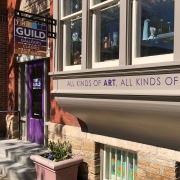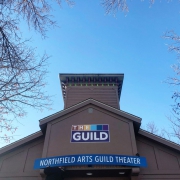
Karen Peter Artist Statement:
Process is deeply rooted in my practice. Process builds form; it provides a beginning and an end. My current sculpture pairs cast iron with wool elements to complete an idea. The work starts with a knit pattern; that is traditionally viewed as soft, comforting and flexible. Then the pattern is cast in iron and becomes rigid, inflexible and heavy. Once the cast piece has been cleaned and finished the wool component of the sculpture is created, using knit or wet felting techniques. This creates sculptures with sharp contrast in color and texture.
Sharp contrast that is intended to challenge the roles implied by process, materials and history. In this recent body of work, the soft object will support the rigid sculpture – challenging the ideas of strong and supportive.
The prints I’m currently creating use a reduction process. The linoleum block is carved away to expose the color printed previously, building the layers of the print. Once this is done you can’t go back – you can only move forward and work with the colors you have chosen. The content of the prints are color and shape, used to form thoughts and ideas that are abstract in daily life. In the prints I meticulously place lines, circles and other shapes to organize these observations. The colors and size of the prints define these feelings or expressions. I enjoy this process as it always pushes me forward.

Justin Peters Artist Statement:
Currently working with cast iron, concrete, and fabricated steel to form and shape sculptures that are representative of boats, air planes and wind turbines. Vessels that have a perceived motion or movement. Images that have long lines pulled from agricultural and industrial machinery. The true integrity of the materials used is important to show the process and fabrication methods used.

Mary Ellen Frame Artist Statement:
I take great joy in all the combinations of colors, shapes and lines of the elements in whatever environment I find myself; I find novelty in their arrangements, how they are sometimes surprisingly juxtaposed.
There are so many different ways that plants express concentric circles and spirals. It’s amazing what water does to sand, how frst and snow transform man-made objects as well as trees and weeds, how changing seasons give us shifting shapes and colors. Water, having no shape or color of its own, takes shape from vessels and wind action, from evaporation and freezing. It transmits and reflects color. Regularity is displayed in the spacing of plants of the same species, or leaf arrangements on individual plants and the clustering of fruit and seeds. Sometimes lines become more appealing when they deviate from parallel. There’s often a sweetness to fringes and frills and feathery texture. Leaves have such myriad veining, shapes, textures and edges that are scalloped, jagged, or smooth. We move through a visual feast.
Mary Ellen Frame




